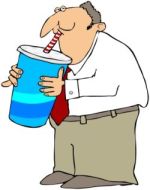Sodium Sources and Functions

Sodium Sources and Functions
All of the nutrient minerals work together to keep you healthy and feeling good. Here is a summary of the role of sodium, a major mineral, in your good health.
| What it does | Maintain fluid balance; normal muscle and nerve function. |
| Daily needs | [Infants: 120-370 mg] [Children: 1,000-1,500 mg] [Men: 1,200-1,500 mg] [Women: 1,200-1,500 mg] [Pregnant: 1,500 mg] [Lactating: 1,500 mg] |
| Not enough | Cramped muscles, malaise SEVERE: Hyponatremia |
| Too Much | Nausea, vomiting, edema Upper Limit: 2300 mg SEVERE: Hypernatremia |
| Foods | Table salt, processed foods, soy sauce, breads, meats |
*The lower value is for infants up to 6 mos.,higher value is for infants up to a year old.
† The first value is for children 1-3 with the amount increasing until age 18.
# Adequate Intake (AI) is the average amount a healthy person consumes; no RDA established.
The science of salt
Sodium is a metallic element, which, in its ionic form, is the positive part of sodium chloride (common table salt) and other sodium compounds.
Necessary for fluid balance
Sodium is mostly found in the fluid outside of the cells along with negative chloride ions. In concert with potassium and chloride, sodium helps to maintain fluid balance and electrolyte balance.
Many foods contain sodium
Sodium compounds are found in many foods. It is particularly abundant in processed foods,and for this reason, it is unlikely that you are not getting enough sodium. Excessive sweating, diarrhea or vomiting may cause a temporary loss of sodium, but actual deficiency from dietary cause is rare. Your body has the ability to adapt the amount of sodium that is retained or excreted based on the needs of the moment.
Interesting Fact about Sodium Sources and Functions: A particular food does not have to taste salty to be high in sodium. Foods with compounds such as sodium benzoate (a preservative) may have higher sodium content than obviously salty foods such as salted peanuts.
Hyponatremia
There is a condition called “hyponatremia,” which athletes can develop during intense or prolonged physical activity. In this situation, where there is excessive sweating and loss of sodium, combined with drinking a large amount of fluid, the sodium in the blood drops to dangerously low levels. This condition requires prompt medical attention to avoid serious consequences.
Certain prescription drugs can make you more susceptible to hyponatremia. For this reason, if you take any prescription drugs, be sure to discuss the potential side effects, as well as dietary implications with your doctor and pharmacist.
Toxicity uncommon
Short-term toxicity is also rare, although dehydration may cause higher levels of sodium in your body. This is easily alleviated by taking fluids.
Caveat for Sodium Sources and Functions: Excessive sodium intake over prolonged periods has been linked with high blood pressure, gastric cancer, kidney stones and osteoporosis.
Salt Sensitivity
Not everyone seems to react to dietary sodium in the same way. For some there is a direct correlation between their sodium or salt intake and their tendency to have high blood pressure. For others, dietary sodium intake seems to have no effect on their blood pressure. This has lead health experts to theorize that there are factors such as heredity, obesity and kidney health that affect an individual’s sensitivity to salt.
Even if you’re not “sensitive,” less is more!
However, everyone may benefit from eating a diet with less sodium. There is significant evidence that those who consume a diet low in sodium and high in potassium can significantly reduce their risk of heart and kidney disease. The easiest way to do this is to limit processed foods and instead, eat fresh, whole foods with little added salt. By changing the way you eat, you can retrain your palate (taste buds) to prefer less salty versions of foods.
Foods particularly high in sodium include the following:
Luncheon meats… Sausage… Bacon… Hotdogs… Corned beef… Caviar… Anchovies… Smoked fish… Herring… Pickles… Olives… Ketchup… Tartar sauce… Worcestershire sauce… Barbeque sauce… Mustard…. Sauerkraut… Canned soups… Potato chips… Pretzels… Crackers… Foods with MSG… Soy sauce… Cheese… Instant pudding… Breakfast cereals… Canned vegetables…

MY TWO CENTS about Sodium Sources and Functions
Historically, salt has been a highly prized commodity. It lends flavor to foods, as well as preserving them. "Salt pork" was a staple in the days before the widespread availability of refrigeration methods. Unfortunately, the salt that is used in most commercially prepared foods and that is found in most salt shakers is a processed variety, adulterated with bleaches and anti-caking agents, and not the natural product that was once so precious.
The good news is that you can still find natural, unprocessed salt, if you are willing to take the time and spend a little more. I use a brand called "Celtic Sea Salt," which is available on-line and in some health food stores. I find that it does not make me thirsty like processed salt does, and the flavor is exquisite. It comes in various forms--all very tasty!
The Upper Intake Level that has been established for sodium for adults is 2300 mg.

